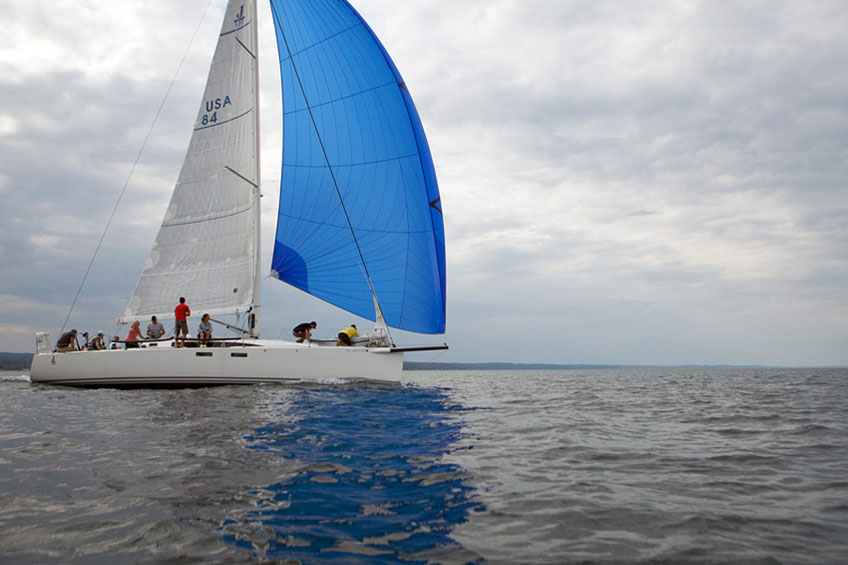Cruising downwind is not as easy as you might think, especially if you need to go dead downwind. Dave Flynn discusses three conditions and how to safely and efficiently sail in them.

Sailing off-the-wind seems so simple: point the boat where you want to go, ease the sails out until they luff, trim them so they are full, and away you go. If your destination is on a reach, this is pretty much all you need to know. However, if your goal is somewhere dead downwind, it’s not quite so simple. In those cases, the fastest course is not necessarily in a straight line. It’s more important to optimize your performance and control downwind. You can do this in three modes.
Mode 1: Up to 12 Knots
If you try to point straight downwind in less than 12 knots, you’ll find that you’re missing a key ingredient: apparent wind. All the wind that your boat is creating by moving forward is straight at you, effectively canceling the true wind. Ten knots of wind and five knots of speed yield five knots of apparent wind, the force that drives the boat. Your solution: Give up on sailing straight downwind and head up. As the boat turns up and sails a closer angle to the wind, it will generate more apparent wind velocity. The lighter the wind, the further you’ll have to turn.
Ask any racing sailor and you’ll realize that the proper angle to sail downwind in less than 12 knots is somewhere between 135-145 degrees true wind angle (TWA). We use true wind angle because apparent wind angle (AWA) changes wildly with relatively small changes in true wind speed. In six knots of breeze at 140 TWA, the apparent wind angle might well be around 90; at 10 knots, it might be at 120 AWA. The AWA is also a function of boat speed: Light, fast boats pull their apparent wind much further forward, even though they may be sailing the same 140 TWA. TWA is the constant.
The seat-of-your-pants methodology is to head up until the sail starts to lift and fill, and you feel good pressure pulling on the sheet. If you bear off slowly and start to lose that pressure, you’ve gone too low. Keep a constant amount of pressure and you’ll find the optimum angle for a given velocity.
If your only sails are upwind headsails, you have a bit of a quandary. Their weight, size, and position (blocked off by the mainsail on a broad reach) make them less effective. The answer is an asymmetrical spinnaker, a sail designed for the job. If you’re going to make longer trips with plenty of downwind work (which is the way it should be!), there’s no substitute.
So in Mode 1 (less than 12 knots), use your asymmetrical and tack downwind at angles between 135 and 145 TWA, whatever allows you to keep sufficient pressure in the sail to fill. You’ll sail further than the straight line course, but the extra speed will more than make up for it.
Mode 2: 12-20 Knots
Once you have 12 knots, the game changes. Now you have enough wind to gradually head closer to dead downwind.
If you’re using an asymmetrical, you can start easing the sheet to sail at deeper angles. True wind angles of 150-160 will become possible, assuming the size and shape of your asymmetrical allows you to sail that deep (a smaller, flatter sail will not work at those angles). Some cruising multihulls use a symmetrical spinnaker tacked to either bow for their dead downwind mode.
If you’re restricted to working headsails, a whisker pole is the key. Poling the headsail out stabilizes the sail and allows you to go anywhere from dead downwind to 20-25 degrees higher. Without a pole, this is not possible. The good news is that modern, carbon whisker poles are dramatically lighter and easier to handle than their aluminum brethren of days gone by.
Mode 3: 20+ Knots
You can sail dead downwind with a poled out headsail in more than 20 knots, or with an asymmetrical at 150-160 TWA, until control becomes an issue. If the boat starts to roll to weather, an accidental jibe is a possibility. Then it’s time to head back up.
You want to make sure the wind is clearly on one side of the boat. With the wind straight behind you, the boat isn’t sure which way it wants to heel or which way it wants to go. Sea state affects this as well: The bigger the waves, the more the boat will roll if you try to sail dead downwind.
As you head up, get rid of the asymmetrical or whisker pole. Depending on the boat type and rig, there are a variety of sail combinations that might work. Regular working sails with a reef in the mainsail and/or a partially furled genoa — or, even better, a proper working jib — are a few options. On a monohull with a big foretriangle, using only the headsail might be a safe, balanced setup. On a cruising multihull, a reef mainsail and no headsail might be the ticket. The trick is to find balance where the sail plan doesn’t cause the boat to round up.
With more than 20 knots, tack downwind for safety and control as opposed to speed. Just like in Mode 1, the best way is not a straight line